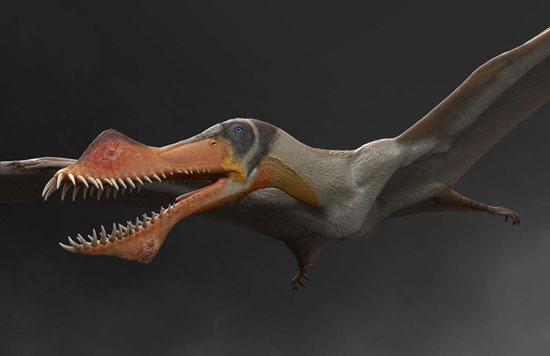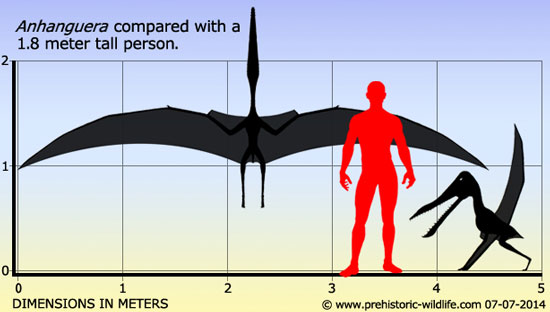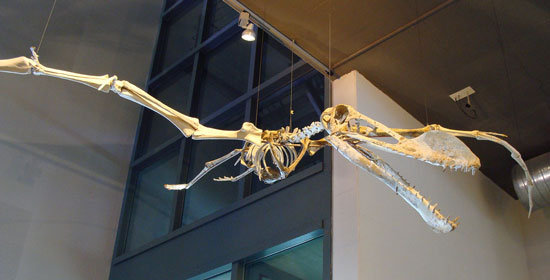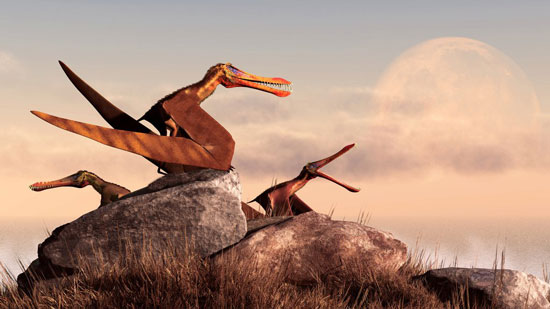|
Today we're going way back in time. These flying reptiles lived from 125 to 115 million years ago. BUT they make a spectacular and terrifying appearance in Profusion. And because of that, I have honored them as today's awesome animal. Notice the Anhanguera at the top of Profusion's cover: Anhanguera (pronounced Ahn-han-gair-ah) means "old devil" in Portuguese. This creature was one of the flying reptiles in the group commonly called pterosaurs. But it is not nearly as well known as the famous pterodactyl. The Anhanguera's fossils weren't discovered until the 1980s. Amazing facts about the Anhanguera This huge flying reptile had a wingspan of 15 feet (4.5 meters), and weighed up to 50 pounds (22.7 kg). They were larger than any flying creature living today. When standing on the ground it was four feet tall. One of the three species of Anhanguera was named after Steven Spielberg. Anhanguera spielbergi was named when a complete fossil was found in Brazil (see the photo below). Apparently, the scientist (I cannot find who it was, exactly) was impressed by Spielberg's work (possibly the Jurrasic Park movies?). In movies and artists' drawings, pterosaurs are often shown as having smooth-skinned bodies and wings (instead of feathers and fur). How do we know that's what they looked like? Amazingly, there are a number of well-preserved fossils of pterosaur skin. Paleontologists have found skin impressions from the wing membranes, throat, head-crests and feet. Not only that, but some of them were also covered with fine hairs, called "ptero-fuzz." I love the name, ptero-fuzz! Due to the structure of their jaws and teeth, it is thought that many of the pterosaurs (including Anhanguera) were fish eaters. In fact, it it likely some of the smaller ones could even dive under the water to catch fish! The Anhanguera had a beak that was wider at the end than near the head, a shape similar to the bills of today's pelicans. This wider end is thought to have increased their chances of catching fish. The Anhanguera had weak back legs, which meant that it probably couldn't walk very fast or very gracefully. Check out this animated video. The video is kind of goofy, but it is downright fun. And most of all, it is considered to be one of the best animations of how these creatures used to move. So, the Anhanguera pterosaur deserves a place in the J.A.H.O.F. (Jam-up Animal Hall of Fame). FUN FACT: Jam-up comes from the word jam, as in close together, or in close contact. Somehow, in America, this gradually became the adjective jam-up, which means perfect. So if you had some really good blackberry jam, you could call it jam-up jam. So, in other words, it's another way to say awesome. Photo Credits:
Flying Anhanguera #1 - Paul A Ramos Anhanguera Size Chart - PrehistoricWildlife.com Coloborhynchus spielbergi - Wikimedia Commons Anhanguera on the rocks - Daniel Eskridge
0 Comments
Leave a Reply. |
Stan's Cogitations
Everyone needs a creative outlet. That's why I write. Archives
July 2024
|






 RSS Feed
RSS Feed